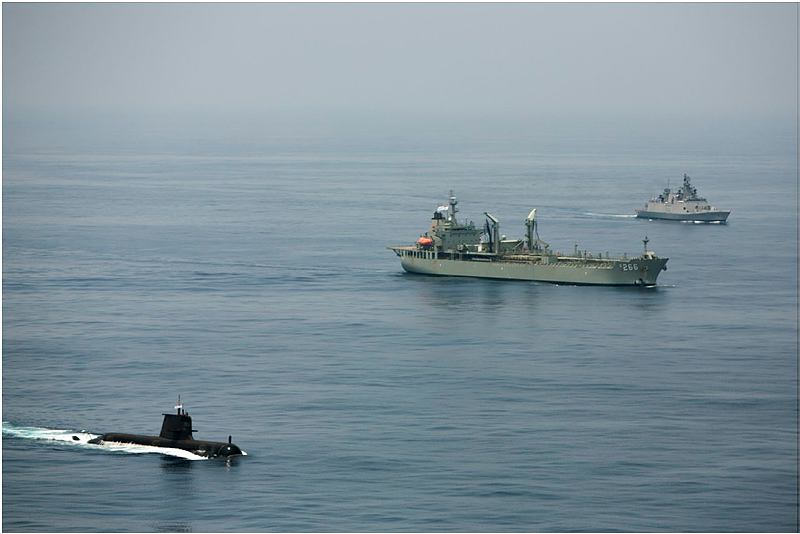
In part 1, I looked at some industry and cost issues associated with an automatic transition of the AN/BYG-1 combat system from Collins to the Future Submarine. In this post, I’ll grapple with capability issues.
As one can imagine, analysis of combat system capability is difficult on account of classification sensitivities (which will be respected here). While Defence might state that their current C2 system ‘is highly capable’, the problem is that Defence can’t always be taken on its word with those sorts of statements.
Harsh? No! Despite critical external reviews of the original ‘TDHS’ C2 system on Collins in 1994 and 1995, Defence went on record in the 1996–97 budget statement, with respect to the TDHS, stating inter alia, that ‘Submarine 01 had completed contractors’ sea trials…to date the performance has met or exceeded the specific requirements’. We later discovered Defence was in denial; a 1998 ‘New Submarine Project’ ANAO review that followed disagreed with Defence, as did the 1999 ‘Macintosh Prescott’ review which ultimately saw the system which had ‘met or exceeded the specific requirements’ abandoned. More specifically to the current BYG, we’ve seen Defence defend the system in the face of criticism from the well-respected US Director of Operation Test and Evaluation (DOTE). Defence has a tradition of backing previous decisions ad infinitum; until Ministerial intervention (think, the Sea Sprite helicopters).
Moving past that, what do we know about the BYG in broad capability terms?
First, when it was selected to replace the TDHS, it wasn’t the most capable C2 system. In fact, it didn’t meet all of Defence’s requirements. It was selected on ‘strategic grounds’—not those of cost or capability. In a competition that preceeded the strategic selection, the German origin ISUS-90 was declared ‘the clearly superior’ system, with DSTO’s Dr Todd Mansell indicating the performance of the STN Atlas system ‘had a margin of about 30% over the Raytheon system’. Of course, the BYG has likely improved since then, but so too has the ISUS-90 (now ISUS-100) and indeed other systems such as the French SUBTIC system. Only baselining would allow Defence to accurately assess the 2015 situation.
Turning to the present, the US DOTE has consistently reported that the ‘BYG’ is:
‘Not effective in supporting operator situational awareness and contact management in areas of high-contact density’ and ‘did not meet the Navy’s requirements for target localization’ and ‘remains not effective in ASW scenarios’.
Noting these are core C2 capabilities such reporting gives cause for concern.
We also know that there are functional integration issues with the system on Collins; more so with respect to ‘levels of integration’. Integration provides advantage in combat systems by allowing a work flow (and complementary data flow) that runs from detection, through classification, localisation and engagement—and back through the system—which enhances the submarine command team’s understanding of the tactical situation.
‘Fully integrated’ systems offer the best capability in this regard. A ‘fully integrated’ analogy might be a car dashboard where the GPS, stereo and mobile phone are integrated seamlessly into the dashboard. Examples of ‘fully integrated’ systems include the S-CUBE sonar/SUBTICS C2 on French designed boats, the CSU-90 sonar/ISUS-90 C2 on German designed boats and indeed the ARCI sonar/BYG C2 on the US boats.
‘Federated’ systems, while having some technical and commercial advantages, generally suffer with respect to functional integration as compared to ‘fully integrated’ system. They are implemented with separate entities doing the C2, sonar, ESM, periscopes etc. A ‘federated’ analogy might be a car dashboard where the GPS, stereo and mobile are mounted into or onto the dashboard, but with a look not quite in tune with the rest of car internals. Examples of a ‘federated’ system include Singapore Type 218 Combat system which consists of a CSU-90 sonar with a Singapore Technologies C2 System, Spain’s S-80 combat system with US origin sonars and Navantia-Faba indigenous C2 System and Swedish submarine combat systems which have Atlas Elektronik sonar suites and SAAB C2 systems. It should be noted that in those examples the owner country has control of the central element of the system, the C2.
Australia plans an integration anathema with the central C2 element of its Federated System not under soverign control. This will bring operational management impediments and disjointed work flow, all packaged with an inconsistent look and feel, which together risks delays and/or confusion during operations, which may cost it dearly in battle. The Australian analogy is a car with the GPS stuck to the window, the stereo mounted under the passenger glove box and the mobile phone laying on the centre console, plugged into the cigarette lighter (when the GPS is not being used).
A second issue with the ‘BYG’ is that of power consumption. It’s well known the BYG, of nuclear submarine origin, has large power consumption needs that increase the submarine’s ‘hotel load’. In turn, this adversely effects the submarine’s all-important indiscretion ratio. Noting the impact this will have on the submarine’s operational stealth, it’s hard to appreciate how Navy can simply ignore this issue.
Ultimately, the Navy is comfortable with what it has and knows. The problem is that this happiness comes without due consideraton and examination of the alternatives. Earlier this year the Navy demonstrated a total lack of understanding as to what other C2 systems can do. In a grilling by Senator Xenophon, the Chief of Navy was left floundering and declaring himself ‘embarrassed professionally’ by answers to questions provided to the Senate on a C2-related question.
Selecting the AN/BYG-1 as the Future Submarine’s combat system is okay, provided it’s an infomed decision. Navy owes it to its future submariners, and the taxpayer, to baseline the system. The best way of doing so is by running a competition.

